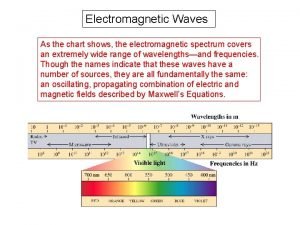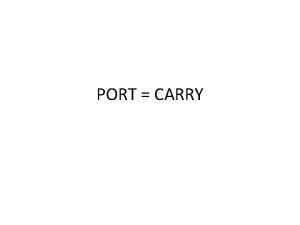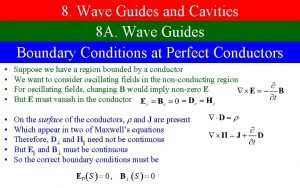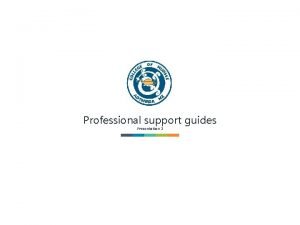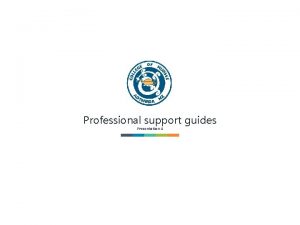Wave guides Wave guides are used to carry














- Slides: 14

Wave guides ØWave guides are used to carry electromagnetic waves. ØWave guide is a hollow metallic tube which can be used to transmit the EM waves where in the transmission due to the reflections from the inner sides of the tube. üThe traveling distance of waves in wave guides depends on the frequency of the wave. üHigher frequency waves travel longer distances through guides than lower ones.

i) Case of high frequency wave - high incident angle ii) Case of medium frequency wave iii) Case of low frequency wave

BUT………………. , Wave guides will carry or propagate signals above a certain frequency, known as CUT OFF frequency, below which the wave transmission is not possible. …. . no wave By solving Maxwell's equations by subjected to appropriate boundary conditions at the walls of the wave guides. Such solutions rise to a number of field configurations. Each configuration is known as a mode.

When EM wave passes through the wave guide, one can define the electromagnetic configurations with in the wave guide. The electromagnetic configurations would be i) Hz = 0 and presence of Ez -----called as TM mode or ELECTRIC WAVES. ii) Ez =0 but presence of Hz MAGNETIC WAVES ------ Transverse Electric modes or



What is TEM mode? TEM means transverse Electromagentic wave where in both of Electric and magnetic fields will become zero at one point.

Wave guides… Shape only matters………. .

Rectangular wave guides are the earliest wave guides of transmission lines. These are used in many applications such as isolaters, detectors, attenuators for various standard wave guide bands of 1 GHz to 220 GHz. Rectangular wave guide can support TE and TM modes but not TEM because one can not define a unique voltage since there is only one conductor in wave guide.

The cut-off frequency in Rectangular wave guide is (TE 1, 0) The cut-off wave length in Rectangular wave guide is

At given operating frequency, only those frequencies which are above cut-off frequency will propagate. The below frequencies will not propagate that means they will decay exponentially and this modes are called cut-off modes.


The dominant mode of propagation (TE 11) in circular waveguide of radius ‘a’ ƛc = 2πa/1. 814 The dominant mode of propagation (TM 01) in circular waveguide of radius ‘a’ ƛc = 2πa/2. 405

Applications ØOptical fibers transmit light and signals for long distances and with a high signal rate. ØIn a microwave oven a waveguide transfers power from the magnetron, where waves are formed, to the cooking chamber. ØIn a radar, a waveguide transfers radio frequency energy to and from the antenna, where the impedance needs to be matched for efficient power transmission. ØA waveguide called a stripline can be created on a printed circuit board, and is used to transmit microwave signals on the board. ØWaveguides are used in scientific instruments to measure optical, acoustic and elastic properties of materials and objects.
 Antigentest åre
Antigentest åre All waves carry
All waves carry Frequency scale chart
Frequency scale chart Electro magnetic chart
Electro magnetic chart Members used to carry wall loads over wall openings
Members used to carry wall loads over wall openings Smart guides adobe illustrator
Smart guides adobe illustrator Munis training manual
Munis training manual 2008 emergency response guidebook
2008 emergency response guidebook Unisa library
Unisa library God guides me
God guides me Cylinder head guides
Cylinder head guides Cubs and bulbul
Cubs and bulbul Iuss health facility guides
Iuss health facility guides Person who guides or directs
Person who guides or directs Association of ukrainian guides
Association of ukrainian guides



